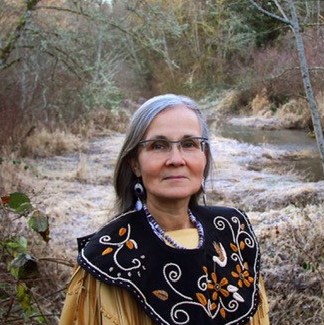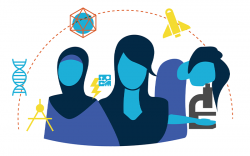Meet Dr. Terry Maresca, MD, Physician and Notable Woman in STEM

Can you explain to us what you do?
I’m primarily a physician. I work as a family doctor, which means I take care of people of all ages. I also work as a teacher of doctors. And I also work with the community, doing things in the realm of environmental health using my own cultural practices – such as seed saving and traditional plant medicine and land restoration.
What was your education and/or career path? How did you get to where you are now?
I went to West Islip High School in New York, a huge public school – my graduating class had 769 students. Back in those days, teachers tracked you and decided what they thought you were capable of. As a result, I did a fair amount of AP math and science classes. Honestly, it wasn’t always for the better – I missed out on Earth science and astronomy, which I might have gone into if I had had that exposure earlier.
Then I went to college for four years, and then to medical school for four years at Vassar College, which is where the actual hands-on training happens. After that there is something called residency, where you learn your specialty. My specialty is family medicine, which means treating what we call the undifferentiated problem – when someone doesn’t know what’s wrong with them. Narrowing the possibilities down takes a tremendous amount of logic and background, which we learn during a 3-year residency.
Lastly, when I decided to do more related to teaching and medicine, I did a year-long teaching fellowship.
“Seed saving is science…Some of the science comes from elders and some is from these experiments that you’re continuously doing – especially with climate change.”
How did you get involved with seed saving?
My own tribal background is Kanienʼkehá꞉ka, which means Mohawk, which is the Indigenous peoples of the Northeast. Part of our teachings relate to the role of women in maintaining agricultural practices such as seed saving.
Seed saving is science. Knowing how and when to grow things and how to preserve seeds was something I learned as a kid. Some of the science comes from elders and some is from these experiments that you’re continuously doing – especially with climate change. It wasn’t a class – it’s just part of life and it’s a responsibility.
What were your most important influences that guided you to STEM?
In the 1960s and 70s, there were very few women doctors. My mom thought I should be a nurse, and I thought: “Well, maybe she’s right – why not try that?” Through junior high and high school, I became a certified nursing assistant and realized that it was not for me. But her encouragement did cause me to consider some kind of healthcare career.
In my senior year of college, I had a genetics professor whose class involved a lot of experiments with fruit flies. But what really struck me was her amazing precision with language. She said: “You have to learn to write really well, because you have to be able to communicate your ideas to people who may not be scientists.” She critiqued not just our science, but also how well we communicated our ideas – and she was merciless. I really loved and respected her, and that lesson in communication has helped my work tremendously.
Here at Washington STEM, we’re starting to talk about early math identity. A positive early math identity, which means knowing you can do math and that you belong in mathematics, help students succeed in STEM. What were some of your most important early experiences in math, and how do you think that impacted your career?
As I mentioned, I took several AP math classes in high school. I did fine on those tests, but you had to have a perfect score to opt out of my college’s year-long freshman math class. So, I ended up taking calculus again as a freshman. That first semester really derailed me – I was struggling to the point where I dropped the class. It was a real moment of questioning myself.
I realized that the way the material was being taught just wasn’t working for me, and I met other students who felt the same way.
The following year I took calculus again with a different teacher and all was well. Sometimes you need to trust yourself or find somebody who has a different approach to the subject material.
What is your favorite part of your job?
I like the long-term relationships I have with people. I like seeing people who are sick become well. I enjoy seeing my physician-students go from nervous and scared to super-competent advocates for the community.
I like working outside, especially land restoration work with the tribes. Some of that involves our plant relatives that are medicinal. To me, all those things are related.
What do you consider your biggest achievement in STEM?
At the University of Washington, I became the first female family physician professor in my department. There are very few Natives nationally who’ve achieved that rank as Indigenous people, and so I’m proud of that. Not because it’s giving me some big soapbox, but insofar as it’s inspiring other people to realize that they could do the same thing.
I think representation is important in all spheres, including academia. It’s important for us to see ourselves and for the non-academic community to say: “Hey, we’re proud of you.”
Are there any stereotypes about women in STEM you’d like to personally dispel?
I don’t face many stereotypes anymore, although I certainly did in the 1970s. There was a lot of questioning around women being doctors. People questioned why I chose family medicine – they told me I had the potential to do more than that. I was like: ‘Are you kidding?’ Family medicine is the most needed area, especially for our tribal communities on reservations and for rural practice, which is what I did for quite some time. I’m starting to pay more attention to being an older person in a STEM field-we still have contributions to make, including supporting the next generation.
You can’t let other people pigeonhole you, whether they think you’re too smart or not smart enough.
What unique qualities do you think you bring to STEM?
I believe in Indigenous science – I don’t think Western science is the only way to look at the world. I bring my own cultural practices into the world of science and reconnect people to those concepts. I think that’s especially important right now as we’re facing climate change.
Although healthcare technology has certainly advanced, we aren’t always the best at providing compassionate care and encouraging people to do their cultural practices. Being able to hold different perspectives is a unique quality for me.

How do you see science, technology, engineering and/or math working together in your current job?
We use a device called a spirometer to diagnose chronic lung conditions like emphysema or asthma. The spirometer is very technical – it interfaces with our electronic health records and performs those tests. Since you have to breathe into a little tube, COVID put a real halt to us using it. When we resumed, no one in the clinic except me remembered how to use it. That’s the advantage of being an older person.
Earlier this week, I was working with one of my trainees, and we had two patients almost back-to-back that used the spirometer. My trainee had to look at the device’s numbers to see whether it was an accurate test, and then interpret the results.
What would you like to say to young women thinking about beginning a career in STEM?
I say go for it. It’s gratifying and never boring. I think you will find like-minded people in whatever field you choose – and some of them won’t be women. There’ll be people of all spectrums who support the work that you do. You’ve got to figure out who those people are, stick with them, and learn from them.
Can you share a fun fact about yourself?
I’ve been in every state in the United States. Besides my home state of New York, I love New Mexico the most. There’s something special about the high desert: the clouds and sky. It’s also a very different world of plants that always leaves me in awe.
There’s room for awe in our lives, and we need to be able to recognize that.